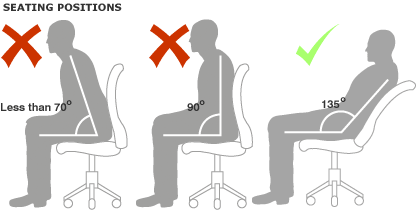Growing up, we were told to "sit up straight" -- not because it's better for our health, but because it looks more productive. As it turns out, sitting up straight (i.e. 90-degree angle at the pelvis) is actually harmful in the long run.
We've known this for a while -- since 2006, actually -- but people keep perpetuating bad facts. Isn't it time to put these myths to an end? Stop sitting up straight! The proper angle is somewhere between 120 and 135 degrees, which looks like this:
Other important sitting posture tips:
- Lumbar support. The lower back area of the spine naturally has a slight inward curve. A chair with lumbar support helps maintain this natural curve and prevents unnecessary stress.
- Support your feet. Ideally, your feet should rest flat on the floor, but if your legs aren't long enough, try resting your feet flat on a footstool. This also reduces stress on your lower back.
- Straight wrists. When typing, your wrists should hover such that your arm and your hand make a straight line. Bending your wrist in either direction can result in painful long-term wrist injuries.
- No armrests. With the proper seat height, your elbows should rest by your sides at a 90-degree angle. Armrests aren't necessary. Not only do they collide with desks (and encourage bad seat height) but leaning on armrests is bad for your shoulders and spine.
Having the right posture can even help you stop getting motion sickness from games. If you sit for long periods of time, it might be smarter to start using a standing desk instead. And if you're on a laptop, you should heed these posture tips when using laptops.
Do you sit at a 135-degree angle? Know of any other posture tips that can help prevent pain and damage? Share your experiences with us in the comments!
Image Credit: Office Woman Back Pain by Lisa S. via Shutterstock


